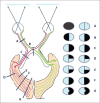Eye Signs in Stroke
- PMID: 36589034
- PMCID: PMC9795711
- DOI: 10.4103/aian.aian_157_22
Eye Signs in Stroke
Abstract
A large part of the central nervous system is involved in the normal functioning of the vision, and hence vision can be affected in a stroke patient. Transient visual symptoms can likewise be a harbinger of stroke and prompt rapid evaluation for the prevention of recurrent stroke. A carotid artery disease can manifest as transient monocular visual loss (TMVL), central retinal artery occlusion (CRAO), anterior ischemic optic neuropathy or ocular ischemic syndrome (OIS). Stroke posterior to the optic chiasm can cause sectoranopias, quadrantanopias, or hemianopias, which can be either congruous or incongruous. Any stroke involving the dorsal stream (occipito-parietal lobe), or ventral stream (occipito-temporal lobe) can manifest with visuospatial perception deficits. Similarly, different ocular motility abnormalities can result from a stroke affecting the cerebrum, cerebellum, or brainstem. Among these deficits, vision and perception disorders are more difficult to overcome. Clinical, experimental, and neuroimaging studies have helped us to understand the anatomical basis, physiological dysfunction, and the underlying mechanisms of these neuro-ophthalmic signs.
Keywords: Dorsal stream; neuro-ophthalmic signs; quadrantanopias; vision.
Copyright: © 2022 Annals of Indian Academy of Neurology.
Conflict of interest statement
There are no conflicts of interest.
Figures







References
-
- Bruno A, Corbet JJ, Biller J. Transient monocular visual loss patterns and associated vascular abnormalities. Stroke. 1990;21:34–9. - PubMed
-
- Furlan AJ, Whisnant JP, Kearns TP. Unilateral visual loss in bright light. An unusual symptom of carotid artery occlusive disease. Arch Neurol. 1979;36:675–6. - PubMed
-
- Gregory YC. Elimination of subjective bruit with compression of temporal artery: New physical sign indicative of internal carotid artery occlusion. Stroke. 1984;15:903–4. - PubMed

